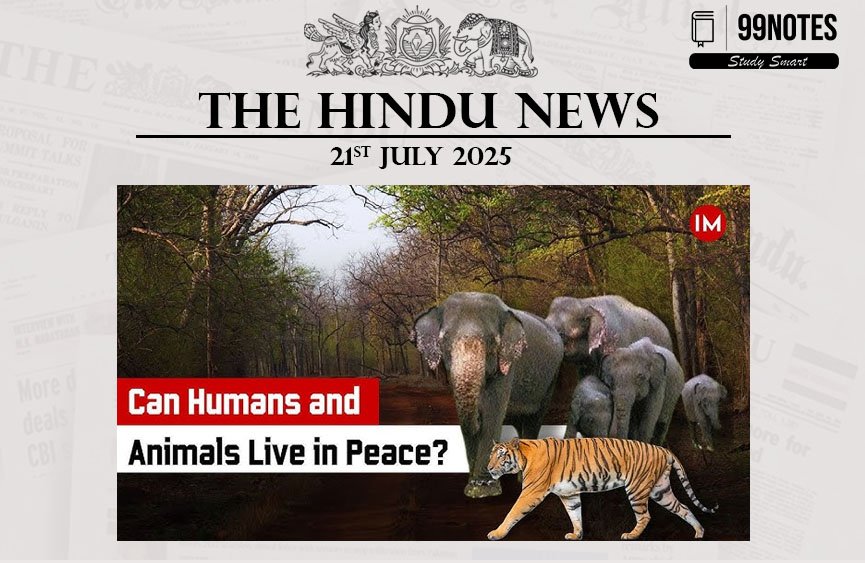21 July 2025: The Hindu Editorial
1. Human-Wildlife Conflict in Maharashtra’s Chandrapur
Source – Page 4, The Hindu Delhi Edition
| Topic: GS3 – Environment & Ecology; GS1 – Geography (Human Settlements) |
| Context |
|
Background: Chandrapur forest hosts India’s highest tiger population density, with increasing cases of human casualties, mostly attributed to habitat fragmentation and encroachment.
Emergence of Conflict:
- Rising tiger population has not matched habitat expansion.
- Expansion of villages, farmlands, highways, and tiger tourism have confined tigers to smaller spaces, increasing encounters.
- 25 deaths reported in first half of 2025, primarily in buffer and territorial zones.
Causes:
- Urbanisation, land fragmentation, and reduced natural prey are major drivers.
- Female tigers and sub-adults, pushed by territorial fights, tend to approach human settlements.
Official Measures:
- Forest department installing camera traps, forming response teams, using real-time surveillance, and community awareness drives.
- Long-term tension between local livelihoods and wildlife security; issues of compensation, translocation, and scientific management.
Socio-cultural Aspects:
- Local rituals and beliefs linked to tiger attacks.
- Demand for more guards during forest resource collection.
|
Practice Question: “Human-wildlife conflict is a major impediment to India’s conservation goals. Analyse the factors behind rising human-tiger conflicts with reference to recent incidents in Maharashtra, and propose a comprehensive management strategy. |
2. Aviation Safety and Regulatory Reform in India
Source -Page 6, The Hindu Delhi Edition
| Topic: GS3 – Infrastructure (Transport); GS2 – Governance & Accountability |
| Context |
|
Key Issues:
- Accidents are the consequence of multi-layered systemic neglect, not isolated pilot errors.
- Regulatory failures in DGCA, Air Traffic Control, and safety due to dilution of statutory safeguards.
- Building approvals near airports, underqualified maintenance staff, overworked pilots and engineers, and ignoring duty-time limitations endanger lives.
Judicial Interventions:
- PILs played a pivotal role in stopping hazardous construction and exposing systemic risks.
Governance Gaps:
- Regulatory capture: safety overseers are themselves often accountable for violations.
- Whistle-blower suppression discourages reporting of safety issues.
- Value of human life compromised for ease of business or infrastructure growth.
Comparison:
- International best practices demand strict, independent, and well-resourced oversight agencies (e.g., FAA, EASA).
- India remains reliant on external clearances for critical airworthiness issues.
Analysis:
- Incentivising profit over safety, skill shortages, lack of transparent mechanisms for redressal and NOC management.
Conclusion/Way Forward:
Immediate reforms in regulatory oversight, enhanced powers and independence for DGCA, strong whistle-blower protection, and judicial accountability are necessary to protect public safety.
|
Practice Question: “Critically analyse the role of regulatory failures in recent aviation accidents in India. Recommend a roadmap to ensure aviation safety and public accountability. |
Read more about –19 July 2025: The Hindu Editorial Analysis

